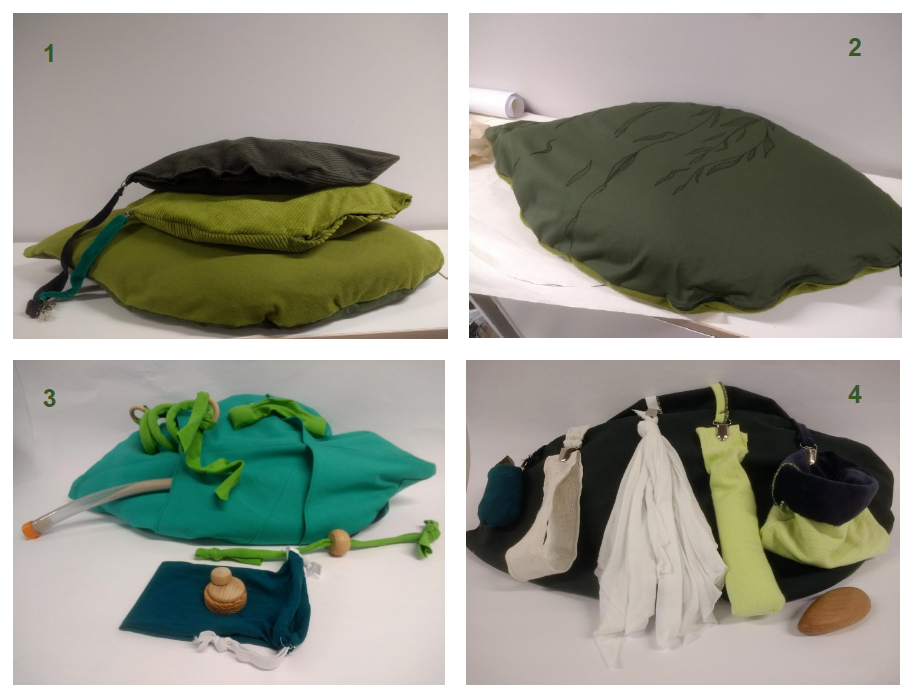By: Sandrine Bohan-Jacquot
Design workshop
At the start of 2019 I was incredibly lucky to be one of the 23 participants attending the 18th International Creativity workshop on ‘Toy Design and Inclusive Play’ in Berlin, Germany. Participants came from Belgium, Colombia, Germany, India, Israel, Japan, Kenya, Lithuania, Philippines, Russia, Thailand, Uganda, USA, Zimbabwe.
You can now watch a video about the workshop, featuring some of the innovative, inclusive toys created by the participants.
The annual workshop was organised by Fördern durch Spielmittel e.V., and is a unique opportunity for designers, psychologists, teachers and social development consultants to interact with groups of people with special needs ranging from children and toddlers to senior citizen.
In total, 23 toys, games and playful products were designed and developed by participants during the 2-week workshop, with support from toy design tutors. There was a final exhibition, opened by the German Ministry of Foreign Affairs. Each toy was discussed to see how it can be produced commercially or how ‘do-it-yourself’ instructions could be published for parents, teachers and carers.
Site visits
The participants visited various inclusive and special kindergartens, schools for children with disabilities and institutions for elderly people with dementia. My group visited the Helene Haeusler special school[1] for primary-age children with intellectual disabilities; 60% of the children do not speak.
The school has very accessible buildings and an incredible range of services, including physiotherapy, speech therapy, a relaxing room, swimming pool, wood workshop, etc. We observed the learning process in a class and my attention was drawn to a 7-year-old boy with physical disabilities and hyperactivity. His uncontrolled movements and constant fidgeting presented a challenge to the teacher as she led the class through the morning routine with a song. I started wondering how I could help this child and his teacher.
Benno, a soothing cushion
With the support of my tutor, Naama Agassi,[2] Designer and University Teacher, I created a soothing cushion. I called the cushion ‘Benno’; a German name which refers to bear, the symbol of Berlin, and means strong and brave.
I was inspired by the willow tree which bends with the wind rather than resisting it (see the story below). The cushion aims to accompany the child’s movements rather than trying to prevent an irrepressible neurological need. The cushion allows the child to sit, move and fidget silently. The child can sit or lie on the cushion. It has two sides; one with a soft fabric for comfort and one filled with spelt balls to accompany the movements. It comes with two small pillows filled with a selection of objects to feel, fidget and play with silently. All elements are noiseless and not too playful in order to be acceptable in class. The selection of elements was adapted for a particular child but could be changed according to needs. It is made of natural material (cotton, wood, cereals and sand) with peaceful colours. Elements are removable for washing.
Several teachers visiting the exhibition asked if they could take pictures of the cushion and its elements because they knew children who would find it useful. I was delighted and hope many more teachers and parents will use and adapt ‘Benno’ to their needs.

Photos:
- The cushion (soft side) and the covers of the small pillows.
- The cushion (side filled with spelt balls).
- Five fidgeting activities are available with each pillow. Shown here: sand fascination; twisting fun; flipping pleasure; merry twirling; spinning enjoyment.
- Five fidgeting activities are available with each pillow. Shown here: surprise pocket; eternal gliding; pure softness; soothing touch; wood treasure.
The oak and the willow, a fable
In a field, there was an oak tree at one end, and a willow tree at the other. Whenever the wind moved through the field, the willow swayed in the wind, while the oak remained unmoved. When this happened, the willow said to itself, “I wish I was as strong as the oak, instead of bending over with every breeze”.
One day a large wind storm whipped through the field. When the storm passed, and the darkness lifted, the willow looked across the field and was shocked to discover that the oak was lying on the ground, broken. When the gardener came into the field, the willow said, “Oh sir, what happened to the oak? How is it that I survived the storm, weak as I am, and the oak fell?”
The gardener said, “Oh little willow tree, do you not understand what happened? When the winds blow, you bend with them, while the oak remains still. So when a really powerful wind comes along, you can bend with the wind, and survive it. But the oak cannot bend, and so if the wind is strong enough, it will break. For the oak had a secret, a weakness within that no one looking at the outside could see”. The gardener went on his way, leaving the willow to ponder what he said.
Strength within and strength without are not the same, and it’s important to cultivate our inner strength first. The willow also shows us the importance of ‘going with the flow’ rather than resisting. The Benno toy does this, it enables the child to channel his/her movements in a comfortable way rather than trying to prevent the movements.
Sandrine is a former consultant with EENET. She now works as Inclusive Education Policy Officer with Humanity and Inclusion.
[1] http://www.helene-haeusler-schule.de Helene Haeusler was a German designer, well known for her line of toys called ‘burlap beasts’ that sought to help children and adults with intellectual or motor disabilities.
